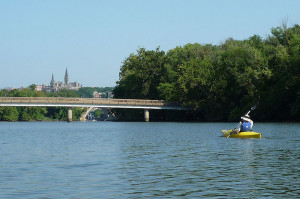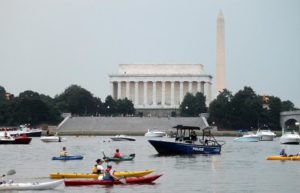 The decades-long mission to build a boathouse for non-motorized vehicles on Arlington’s side of the Potomac River has moved one step closer to reality. After several failed attempts, an environmental impact study is now underway.
The decades-long mission to build a boathouse for non-motorized vehicles on Arlington’s side of the Potomac River has moved one step closer to reality. After several failed attempts, an environmental impact study is now underway.
Arlington cannot proceed with building a boathouse without approval from the National Park Service, because the waterfront land along this side of the Potomac River actually belongs to NPS. By law, NPS is required to perform a study about how such a venture would impact the cultural and natural resources in the area.
Estimated to take from two to three years, an environmental impact study is the longer and more thorough of two main studies that can be performed. The other is an environmental assessment, which is done on less controversial matters and typically takes one to two years. Environmental assessments had previously been initiated for an Arlington boathouse, but due to various limiting factors including staffing and lack of resources, they were scrapped. This time, all involved parties are dedicated to seeing the EIS through.
“The real emphasis is to make sure it’s really done thoroughly,” said National Park Service Environmental Protection Specialist Thomas Sheffer. “Because with a couple of false starts, we want to make sure this comes to a conclusion.”
The process was re-initiated in late summer, and Arlington was approved as a cooperating agency in the fall. A federal register notice has been submitted, but the process cannot move forward until the notice is officially approved and posted publicly.
Three main sites are being examined for the boathouse. The first is called “Lower Rosslyn” and consists of the area directly along the river near the entrance to Theodore Roosevelt Island. The second is called “Upper Rosslyn,” close to where Lee Highway, I-66 and the Key Bridge converge. A multi-level hybrid of the two Rosslyn locations could be a possibility. Another site is Gravelly Point, which allows for a more spacious facility but has less ideal conditions for rowers because of wind and motorized boats. Daingerfield Island, though not in Arlington County, is also being considered.
After the EIS concludes and a site is chosen, it will be some time before Arlington residents actually get to use a finished boathouse. Public meetings would ensue, followed by final approval of a plan, and a competitive process to find a company to construct the boathouse. Considering the EIS portion isn’t even expected to be finished before the winter of 2013, a completed structure is likely years away. Additionally, the entire idea could be abandoned if no sites are deemed acceptable. However, Arlington is hopeful the boathouse will eventually reach fruition.
“The County is excited to be at this point in the process and excited about the opportunity presented by the Park Service to be an operating agency in the EIS,” Arlington County Federal Liaison Brian Stout said. “It appears they’re taking a very thoughtful approach to this.”
The Park Service has voiced a number of concerns about development on Arlington’s side of the Potomac. Some of those include harm to species along the river, negative impact on cultural sites such as Theodore Roosevelt Island and the area’s position along a flood plane. Arlington County thinks the concerns are valid, but can be worked around.
“We think they can be overcome, and there are answers,” said Stout. “We think there are a lot of ways for us to achieve all of the goals of increased access to the water while staying true to the Park Service goals as well.”
 Stout points out that other boat clubs along the river have been stretched thin, both for high school rowing and community access to non-motorized boats. He believes allowing Arlington to build a boathouse would benefit the area in general by alleviating stress on some other facilities, such as the Potomac Boat Club and the Anacostia Community Boathouse.
Stout points out that other boat clubs along the river have been stretched thin, both for high school rowing and community access to non-motorized boats. He believes allowing Arlington to build a boathouse would benefit the area in general by alleviating stress on some other facilities, such as the Potomac Boat Club and the Anacostia Community Boathouse.
Rep. Jim Moran is recognized by all parties for his push to get funding for an EIS. He continues to support building an Arlington boathouse.
“We would not be where we are without Congressman Moran. He’s got a close working relationship with the Park Service and the Department of the Interior,” Stout said. “He’s helped to keep them at the table and push them along with this. That’s been incredibly helpful.”
Although NPS foots the bill for performing an environmental impact study, the funding for the potential building and staffing of a boathouse has not yet been determined. Such details are not included in the EIS, but would be discussed once a site gets final approval and a formal plan is drawn up. However, Sheffer notes it would be unlikely the Park Service would supply monetary support.
Once the federal register notice is published, public meetings will take place to explain more details of the EIS and what comes next. Public input would be taken into consideration for drawing up various drafts of an environmental plan. In the meantime, the county and NPS will hold internal meetings to sort out preliminary details. They’re getting together today to look at preparations for public sessions and to address potential issues that may arise.
An email newsletter is being set up to keep the public informed of developments and upcoming meetings in the next few months. Anyone interested in being added to the newsletter list can send an email request to [email protected].
“We’re making sure that we get a lot of voices heard in the public scoping process,” Sheffer said. “That really sets the process off on the right foot.”

